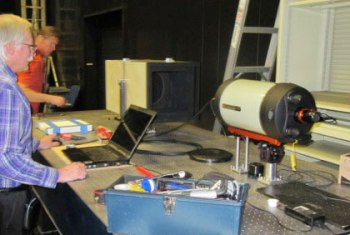Apr 6 2013
The Space Engineering Research Center (SERC) delivered an innovative star field simulator to technical personnel at NASA’s Marshall Space Flight Center (MSFC) in Huntsville, Ala., in March.
 Dr. Tom Pollock (foreground) begins checkout of the Star Field Simulator delivered to NASA Marshall
Dr. Tom Pollock (foreground) begins checkout of the Star Field Simulator delivered to NASA Marshall
The simulator provides a realistic simulation of what a NASA space-based telescope would see when viewing the night sky under a variety of conditions, for use by NASA to test star trackers and other space cameras. The simulator was a collaboration between SERC and Texas A&M University’s Department of Aerospace Engineering, with Dr. Tom Pollock leading the design and development of the system, and SERC's Dr. Christian Bruccoleri leading the software development.
Pictured: Dr. Tom Pollock (foreground) begins checkout of the Star Field Simulator delivered to NASA Marshall
The star field simulator delivered to NASA is an adaptation of a capability developed at SERC’s Sensor Test Laboratory, in which flat panel displays are used to present the simulated space scenes to the camera. This makes use of a sophisticated model developed by Texas A&M Engineering researchers called Virtual Sky Imager, in which all camera, orbit and noise parameters are accurately modeled; and Sensor Test Lab software that corrects for all errors associated with presentation and testing.
The NASA configuration was especially challenging in that a star catalog of millions of stars was required; a collimating lens, baffles and reflecting mirror were needed to simulate stars at “infinity” for the actual NASA telescope that was part of the setup; and a state-of-the-art medical monitor was needed to achieve the high resolution required.
The simulator was set up and tested at the Sensor Test Lab before delivery. Undergraduate students Peter Mack Grubb (computer engineering), Taylor Dowlen (applied mathematical sciences) and John Mayo (mechanical engineering) all had key roles in the star field simulator development.
Pollock and SERC Director Chip Hill drove the equipment to Huntsville and set it up in NASA’s facility. This high bay facility has historical significance as the original Redstone rocket processing facility during the period of time it was overseen by Dr. Werner Von Braun’s rocket team. The telescope, collimating lens and baffles were installed on an optics table, the monitor was mounted to a plate on the opposite side of the building, and the computer installed at a nearby station.
Set up and initial testing was accomplished in a day. The SERC/TAMU team will complete other software refinements as the NASA personnel check out their new simulator and provide those as required. Although several industry cameras have been tested in SERC’s lab, this is the first instance of exporting this capability to another user.
SERC is a research center in the Texas A&M Engineering Experiment Station, a member of the Texas A&M University System